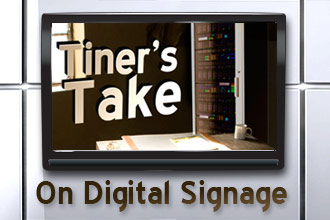Metrics Count
 Last month, I wrote about the need to define a strategy for your digital signage applications. As the integrator, this is as important for you as it is for the business to whom you are selling. If you sell a product and a few months later the company is wondering why they bought that product, they may also start questioning why you sold it to them. The second step in working out a digital signage strategy is collecting and understanding metrics. At this point you and your customer know why you implemented the system, now you need to understand if it is accomplishing that goal.
Last month, I wrote about the need to define a strategy for your digital signage applications. As the integrator, this is as important for you as it is for the business to whom you are selling. If you sell a product and a few months later the company is wondering why they bought that product, they may also start questioning why you sold it to them. The second step in working out a digital signage strategy is collecting and understanding metrics. At this point you and your customer know why you implemented the system, now you need to understand if it is accomplishing that goal.
Different signage systems have different methods of analytics, along with different goals. An interactive touch screen monitor is perhaps the simplest method to track analytics. These monitors are often found in hotel lobbies. Presumably you have already worked with the hotel management to understand why they want an interactive sign in the lobby. Is it to increase their customer service, by providing local information on restaurants, directions and attractions? If so, recording the number of “touches” and the most popular features used (directions, for example) will let your customer know if they are reaching that goal of improved customer service. These metrics will also let them know if they need to make changes to the design to attract more users. Quantitative data that is provided directly by the system is much more reliable, and much easier to analyze than qualitative data provided by the front desk clerk who can give anecdotal information about the uses of the sign. A different strategy for a sign in a hotel lobby may be to generate revenue. Perhaps you sell sign space to local restaurants. Depending on the investment the restaurant makes, is how they rank in your presentation to the customers. As the strategy is different, the metrics must be different. In this case, your customer is the restaurant, and they will want to know how many times their name was put in front of someone looking for a place to eat. With an interactive screen, those metrics should be easy to produce.
 A very typical digital signage strategy would be to draw customers to a particular item in a store, whether that item is a loss leader, or has a high margin. If your strategy is a loss leader, a second part of that strategy is to sell other things to the customer as they wander the store looking for that loss leader item. So, the metrics you want to measure are the amount of money spent per customer, in combination with the loss leader. Typically, a store will want to sell a specific item along with the loss leader. So, perhaps the store has a sale on shaving cream, but is hoping that customers also buy a razor. The digital signage can play a role by directing customers to the loss leader in a way that puts them directly in front of the razors that they really want to sell. Again, the metrics that will need to be measured are the number of razors sold in combination with the shaving cream. Alternately, you may have a strategy to sell a particular item with a high margin. In this case the store would use the digital signage system to attract their customers to that item. Metrics on how many of that item are sold would not be useful in this case. You don’t know that it was your digital signage that led them there. Instead, you would need to collect a metric that was a clear indication of success with the sign. A call to action, such as taking a picture of the sign as a “digital coupon”, or scanning a QR code, or mentioning a code to the cashier, would all be valuable metrics to determine the success of the sign.
A very typical digital signage strategy would be to draw customers to a particular item in a store, whether that item is a loss leader, or has a high margin. If your strategy is a loss leader, a second part of that strategy is to sell other things to the customer as they wander the store looking for that loss leader item. So, the metrics you want to measure are the amount of money spent per customer, in combination with the loss leader. Typically, a store will want to sell a specific item along with the loss leader. So, perhaps the store has a sale on shaving cream, but is hoping that customers also buy a razor. The digital signage can play a role by directing customers to the loss leader in a way that puts them directly in front of the razors that they really want to sell. Again, the metrics that will need to be measured are the number of razors sold in combination with the shaving cream. Alternately, you may have a strategy to sell a particular item with a high margin. In this case the store would use the digital signage system to attract their customers to that item. Metrics on how many of that item are sold would not be useful in this case. You don’t know that it was your digital signage that led them there. Instead, you would need to collect a metric that was a clear indication of success with the sign. A call to action, such as taking a picture of the sign as a “digital coupon”, or scanning a QR code, or mentioning a code to the cashier, would all be valuable metrics to determine the success of the sign.
Perhaps one of the most exciting advances in digital signage metrics is the growth of Anonymous Video Analytics (AVA). I will take a moment here to emphasize the anonymous aspect. These systems do not need to collect and store video. Rather, they analyze it in real time. Intel is currently a leader in AVA and has a lot of interesting information on its website about the technology. Essentially, it uses a camera mounted on the sign and analyzes the video. The analytics are able to determine gender, age and other demographic information. The technology is very useful if you are implementing an informational strategy. You can determine the amount of time a person spent standing at the sign, which bulletins got the most attention and what type of customer looked at it. If your strategy is to sell advertisements on the sign (think of a sign mounted in the corridor of a mall) you can report the metrics back to the people buying advertisements. Also, AVA will allow you to show specific advertisements to specific customers. A younger (20-25) customer may be directed to Abercrombie and Fitch, for example. A mother pushing a child in stroller may be directed to Kids R Us. You can collect metrics on how many of each customer type were directed to each store.
The most critical piece of collecting metrics is to only collect the metrics that are going to help you understand if you are achieving your strategy. There is lots of data available, but as the integrator, you need to help your customers understand what they need. If you continuously talk strategy, and help them collect and analyze data based on that strategy, you will have happy customers who come back for more product.





